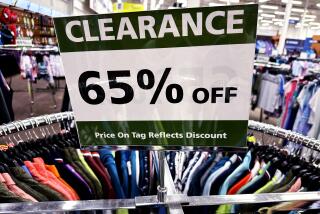Core prices rise faster in May, causing fears of stagflation
Higher prices seeped from the gas pump into the broader U.S. economy in May, adding new hurdles for the sluggish recovery and the government’s options for boosting it.
The combination of a stagnant economy and rising inflation led some economists to worry that the country might be headed toward a repeat of the 1970s phenomenon of stagflation, which hobbled growth for years.
Wednesday’s Labor Department report rattled financial markets already spooked by the worsening debt situation in Greece and raised the specter that the Federal Reserve might have to raise interest rates sooner than expected to blunt inflation pressures.
The report helped accelerate the recent slide in the stock markets. The Dow Jones industrial average plummeted 178.84 points, or nearly 1.5%.
Economists cautioned that inflation is volatile and could sink in coming months if gasoline prices continue their recent downward trend.
But for a nation still struggling to shake off the effects of the deep recession, the prospect of higher prices for clothing, hotel rooms and a host of goods and services while wages remain flat could open up another pothole on the road to recovery.
“It complicates efforts to deal with the economy,” said Gary Schlossberg, senior economist at Wells Capital Management in San Francisco. “I don’t want to jump the gun. I don’t think we’re at stagflation. But it certainly is an issue that bears watching.”
Consumer prices rose 0.2% last month, the smallest increase in six months, as lower gasoline prices helped keep overall costs down, the Labor Department said Wednesday.
But core inflation — which reflects prices of goods other than food and energy — was 0.3%, the highest since July 2008.
That helped push up overall consumer prices 3.6% over the last 12 months.
Chris Rupkey, chief financial economist for the Bank of Tokyo-Mitsubishi in New York, called the new data “unsettling” and predicted that they would increase pressure on the Fed to start raising near-zero interest rates.
The news may end any efforts that the nation’s central bank might have been contemplating to further spur the slow recovery.
“A couple of months ago, they said, ‘Don’t worry about food and energy, focus on the core.’ Now some of the food and energy cost is affecting the price of other goods,” Rupkey said.
Energy prices declined 1% in May, the first drop in nearly a year, aided by a 2% drop in gasoline prices that had been sky high. But food prices continued their rise in May, up 0.4%, the same as in April.
The increase in core inflation in May was spurred by higher prices for clothing, new vehicles, hotel rooms and recreation. Core inflation was 0.2% in April.
Although rising inflation can develop into a problem, a small dose isn’t necessarily bad, economists said.
It could, for instance, help raise the value of real estate while effectively making money cheaper, which could increase spending, said Vincent Reinhart, a resident scholar at the American Enterprise Institute and former Fed official.
“You’re not going to get a central bank to applaud an increase in inflation, but you’re also not going to make them real nervous if inflation’s below their expectations,” Reinhart said.
The fear several months ago was of falling prices — deflation — which was a major reason the Fed decided to pump an additional $600 billion into the economy. Prices often rise as the economy recovers because businesses feel that consumers finally can afford to pay more.
“What we buy, somebody sells. If prices are going up, it can’t hurt revenues, and if revenues go up, you get some benefit in hiring,” Schlossberg said.
Continually rising prices create trouble, but that hasn’t happened yet. Core prices are up 1.5% over the last 12 months, which is less than the Fed’s implicit target of less than 2%.
Inflation fears, however, make it more difficult to provide stimulus to the economy, tying the hands of government officials as they search for ways to quicken the pace of recovery. The latest data probably kill any chance that the Fed would authorize another round of bond buying to stimulate the economy, Reinhart said.
And inflation concerns make it more difficult for the White House to try to spur job growth. President Obama is almost forced into a wait-and-hope approach, analysts said.
“There’s not a huge strategy out there right now,” said Harry Holzer, an economist at the Urban Institute and at Georgetown University. “What’s troubling is the current trend is all about reducing spending — and that’s going to make things even worse.”
Since the victory by many “tea party” conservatives in the midterm elections last fall, Republicans have put Obama and congressional Democrats on the defensive by focusing public debate on the nation’s debts, not jobs or economic growth.
GOP leaders have insisted that any deal to break the budget impasse and avert a disastrous default on American debt must be accompanied by significant spending cuts — even though many experts, including Fed Chairman Ben S. Bernanke, warn that a government pullback now could undermine the recovery.
Bernanke acknowledged last week that there was little more the Fed could do, bluntly saying that “monetary policy cannot be a panacea” for such problems as the poor performance of the job market.
One of the ideas the Obama administration has floated is a continuation of the Social Security payroll tax cut for employees, which took effect this year and cut most workers’ tax obligations by 2 percentage points.
That additional money in people’s pockets was aimed at pumping up consumer spending, but the economic benefits have been blunted by gasoline prices that had been soaring until just recently.
Some on Capitol Hill have talked about extending the payroll tax cut to employers’ share, a move that could make the idea more attractive to Republicans. But Obama administration officials and leading congressional Democrats took a dim view of that prospect.
Before the recent downturn, Obama had shifted from policies aimed at short-term growth to those addressing longer-range concerns. The economy seemed to be on the mend, and he had little choice but to urge the private sector to do more because the government wasn’t going to do so.
Now inflation could make government action even less likely amid a struggling recovery.
Rupkey said the higher overall prices indicated stronger consumer demand and reduced the potential for a double-dip recession.
But with unemployment still high at 9.1% after a disappointing May jobs report, the Fed has to balance the continued benefit of historically low interest rates with inflation concerns.
Rupkey predicted interest rates could start rising in the first three months of 2012 if price increases continue.








